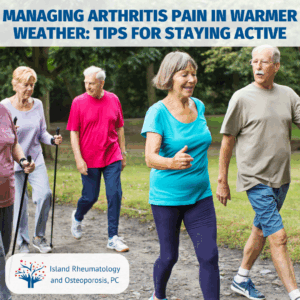Managing Arthritis Pain in Warmer Weather: Tips for Staying Active
 As summer arrives on Long Island, many people look forward to spending more time outdoors. For those living with arthritis, however, warmer weather can present both opportunities and unique challenges. While some find that heat and sunshine help relax muscles and ease joint stiffness, others may notice increased swelling, discomfort, or fatigue due to changes in temperature, humidity, and activity levels. At Island Rheumatology and Osteoporosis PC, we’re committed to helping you stay active, comfortable, and healthy all season long.
As summer arrives on Long Island, many people look forward to spending more time outdoors. For those living with arthritis, however, warmer weather can present both opportunities and unique challenges. While some find that heat and sunshine help relax muscles and ease joint stiffness, others may notice increased swelling, discomfort, or fatigue due to changes in temperature, humidity, and activity levels. At Island Rheumatology and Osteoporosis PC, we’re committed to helping you stay active, comfortable, and healthy all season long.
How Does Warm Weather Affect Arthritis?
-
Muscle Relaxation: Warmer temperatures can help muscles, ligaments, and tendons loosen up, improving flexibility and reducing joint stiffness.
-
Barometric Pressure & Humidity: Fluctuations in barometric pressure and high humidity may cause joints to feel swollen or more sensitive, especially in autoimmune forms of arthritis.
-
Dehydration Risk: Hot weather increases the risk of dehydration, which can worsen joint pain and fatigue.
Tips for Managing Arthritis Pain and Staying Active
1. Choose Low-Impact Activities
Staying active is essential for joint health, but it’s important to select exercises that minimize stress on your joints:
-
Walking, swimming, cycling, and water aerobics are excellent options for summer.
-
Yoga, tai chi, and gentle stretching can improve flexibility and reduce stiffness.
-
Aim for 20–30 minutes of activity most days, but listen to your body and avoid overexertion.
2. Time Your Exercise Wisely
-
Exercise during cooler parts of the day, such as early morning or evening, to avoid excessive heat and humidity.
-
Warm up with gentle movements or a warm shower to loosen stiff joints before activity.
-
Cool down with stretches and, if needed, apply a cold pack to reduce post-activity swelling.
3. Stay Hydrated
-
Drink plenty of water throughout the day to keep joints lubricated and reduce fatigue.
-
Limit caffeinated and alcoholic beverages, which can contribute to dehydration.
-
Include hydrating foods like cucumbers, melons, and oranges in your diet.
4. Eat an Anti-Inflammatory Diet
-
Focus on foods rich in omega-3 fatty acids (fish, flaxseeds, walnuts), leafy greens, berries, and nuts to help reduce inflammation.
-
Limit processed foods, excess sugar, and fried foods, which can worsen inflammation.
5. Use Heat and Cold Therapy
-
Apply heat (warm towels, heating pads, or warm baths) before activity to relax muscles and ease stiffness.
-
Use cold packs after activity to reduce swelling and numb sharp pain.
6. Protect Your Joints
-
Wear supportive footwear and consider braces or compression sleeves if needed for extra stability.
-
Use ergonomic tools for gardening and household tasks to minimize joint strain.
-
Take frequent breaks, avoid repetitive motions, and pace yourself during activities.
7. Monitor Your Symptoms
-
Keep a journal to track how your body responds to different weather conditions and activities.
-
Share this information with your rheumatologist to help tailor your management plan.
When to Seek Help
If you experience persistent or worsening pain, swelling, or difficulty with daily activities, consult your rheumatology team. Adjustments in your treatment plan, physical therapy, or additional support may be needed to help you stay active and comfortable.
Enjoy the Summer—Safely and Comfortably
With the right strategies, you can make the most of the warmer months while keeping arthritis pain in check. At Island Rheumatology and Osteoporosis PC, we’re here to support you every step of the way. Stay active, stay hydrated, and don’t hesitate to reach out with questions or concerns about your arthritis care.

